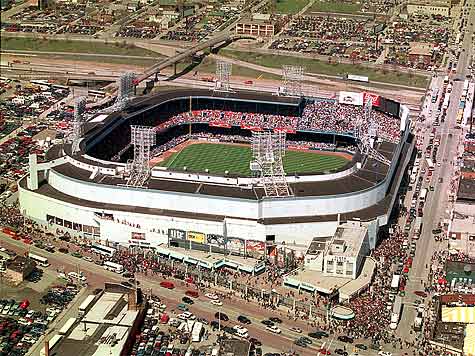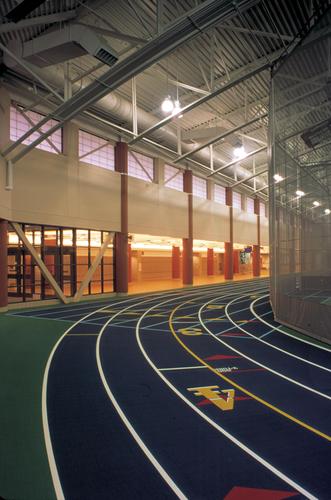Unfortunately, for every sports venue that has been saved, there have been at least one or more sports venues that were demolished. While some demolished venues were beyond repair, most have been in excellent condition on their demolition day. To make matters worse, a lot development projects that were promised to fulfill their space have never materialized.
While the city of Evansville claims to be on better footing for Roberts Stadium's replacement, it's important to remember the risks involved here. Part of the funding for the ballfields is to come from "Recovery Zone" funds. Is anyone else a little nervous that the Wesselman Woods area may not qualify as a "Recovery Zone?" And what if the 100,000 projected people never show up ( Other nearby baseball complexs are only drawing 40,000). Roberts Stadium is already built and can always be modified later if the city believes it is beyond repair down the road. However, once it's gone, there's no looking back.
There are several cities in the U.S that are regretting their decision to demolish their venue(s). Here are my top 5 sports venues that I believe should have never been demolished...
5.
Market Square Arena- Indianapolis, Indiana:
http://www.lostindiana.net/Lost_Indiana/Lost_Indiana__Market_Square_Arena.html

Market Square Arena was best known as the home of the Indiana Pacers of the American Basketball Association and National Basketball Association from 1974–1999. The arena was also the site of the final concert held by Elvis Presley on June 26, 1977. The arena, completed in 1974 at a cost of $23 million, seated 16,530 for basketball and 15,993 for ice hockey.
The original student design included a four-story office building covering two city blocks. The Market Square Arena as constructed consisted of a unique space frame design spanning Market Street. The playing floor was elevated over Market Street by parking garages on either side of Market Street. Market Street terminated at Market Square Arena to the east and to the west by the capitol building. The final design eventually took up one city block spanning Market Street.
Market Square Arena was demolished on July 8, 2001, and today two gravel, yes gravel, parking lots occupy its space, which is illegal because all parking lots must be paved within 1 year of demolition in Indianapolis.
"Originally, several large projects were proposed, including a high-rise condominium and retail space planned a few years ago, but that plan fell through as the economy tanked.
Now that the gravel variance has expired, the CIB plans to pave the lots at a cost of $800,000 tax dollars, with parking fees used to eventually cover the cost. Even that plan is temporary."
http://www.theindychannel.com/news/25037501/detail.html
Instead of converting it to office space and condos, the city is left with two gravel parking lots. Talk about a debacle!
4.
Orange Bowl- Miami, Florida:

The Orange Bowl, formerly Burdine Stadium, was an outdoor athletic stadium in Miami, Florida, west of downtown in Little Havana. Considered a landmark, it was the home stadium for the Miami Hurricanes college football team. It also hosted the professional Miami Dolphins for their first 21 seasons.
Besides being home to the NFL's only unbeaten team (1972 Dolphins), The Orange Bowl was also the site of the NCAA's longest college football home field winning streak. Between 1985 and 1994, the Miami Hurricanes won 58 straight home games at the Bowl, until ended by the Washington Huskies. The stadium's home field advantage used to include a steel structure that fans would set to rumbling by stomping their feet. Concrete reinforcement had silenced the rumble. There was still the advantage of the West End Zone, which has a relatively narrow radius that amplifies fan noise. The West End Zone was a factor in the Wide Right curse, in which the Florida State Seminoles lost a series of close games due to missed field goals. This section was so raucous that some football announcers often confused it with the student section. In fact, the fans in this section were the working and lower middle class citizens of Miami.
The City of Miami embarked on a plan to extensively renovate the stadium. However, those plans fell by the wayside as Miami focused on keeping the Florida Marlins in town, forcing the Hurricanes to threaten a move to Dolphin Stadium in suburban Miami Gardens if a plan to renovate the stadium were not in place within 45 days. Some feared that Miami would permit the college to leave, only to tear down the Orange Bowl and replace it with the new stadium for the Marlins.
That fear became reality as Paul Dee, Athletic Director for the University of Miami, announced that the Hurricanes would be moving to Dolphin Stadium for the 2008 season. Dee and university president Donna Shalala made the announcement during a press conference at the Hecht Athletic Center on August 21, 2007. The University agreed to a 25-year contract to play at then Dolphin Stadium. According to Miami City Manager Pete Hernandez, this put the Orange Bowl back in the forefront as a possible site for a new Marlins stadium. The hope that talks would resume soon on that possibility vanished after only a short while.
Many Hurricane fans vocally opposed the decision to move stadium locations and preferred maintaining the Orange Bowl as the Hurricanes' home field, out of concern of Dolphin Stadium's extra distance from campus, the severing of an icon of the Hurricanes' historical successes on the field, and potentially more expensive parking costs.
Many fans have even stated to various broadcast, print and internet-based media outlets that they will no longer attend the games of Hurricanes football, once the team abandoned the Orange Bowl. Some speculate that the decision to leave the Orange Bowl might have cursed the Miami Hurricanes and would cite the Miami Dolphins as a precedent. Indeed a common explanation for the Miami Hurricanes' poor performance during the 2007 season is that "they've never been the same since they left the Orange Bowl."
The Orange Bowl was demolished in May 2008. What a shame!
3.
Texas Stadium- Irving, Texas

Built to replace the aging Cotton Bowl, Texas Stadium was the home field of the NFL's Dallas Cowboys from 1971 to 2008, and had a seating capacity of 65,675.
Texas Stadium was to have originally been a stadium with a retractable roof, but the stadium could not support the weight of the entire roof. This resulted in most of the stands being enclosed but not the playing field itself. This unusual arrangement — more commonly seen in European soccer stadiums — prompted Cowboys linebacker D. D. Lewis to make his now-famous quip "Texas Stadium has a hole in its roof so God can watch His favorite team play."
Despite developers willing to turn the stadium into an indoor ski resort (
http://dallasdirt.dmagazine.com/2010/04/14/texas-stadium-implosion-what-would-be-there-if-they-had-not-brought-the-stadium-down/) or a soccer stadium for a new MLS team, the city of Irving decided to implode the stadium on April 11, 2009.
Currently the city leases the land to the Texas Department of Transportation for a highway construction staging area. What a waste of valuable NFL history!
2.
Old Yankee Stadium- Bronx, New York

Nicknamed " The House That Ruth Built," Yankee Stadium was best known for its frieze that hung around the parks upper facade.
The venue was constructed for $2.4 million between 1922–1923 specifically for the Yankees, who had been sharing the Polo Grounds with the New York Giants baseball team for 10 years. Yankee Stadium opened in 1923, and at the time, it was hailed as a one-of-a-kind facility in the country for its size. Over the course of its history, it became one of the most famous venues in the United States, having hosted a variety of events and historic moments during its existence. While many of these moments were baseball-related—including World Series games, no-hitters, perfect games, and historic home runs—the stadium also hosted boxing matches, concerts, and three Papal Masses.
During the Yankees 85 years at the Stadium, 26 World Series titles were won by the franchise.
Despite proposals to convert Yankee Stadium into a high school, museum, hall of fame, train station, and even a mall, the city went ahead with demolition on November 4, 2009. History had repeated itself. The same city that demolished Ebbets Field and the Polo Grounds had once again demolished a historic ballapark. Only a small park named Heritage Field will be left on the site. A true disgrace to "Baseball's Cathedral!"
1.
Tiger Stadium- Detroit, Michigan

Tiger Stadium (formerly known as Navin Field and Briggs Stadium) was a stadium located in the Corktown neighborhood of Detroit, Michigan. It hosted the Detroit Tigers Major League Baseball team from 1912 to 1999, as well as the National Football League's Detroit Lions from 1938 to 1974. It was declared a State of Michigan Historic Site in 1975 and has been listed on the National Register of Historic Places since 1989. The stadium was nicknamed "The Corner" for its location on Michigan Avenue and Trumbull Avenue.
Many private parties, non-profit organizations and financiers expressed interest in saving the ballpark after its closure. These included multiple proposals to convert the stadium into mixed-use condominiums and residential lofts overlooking the existing playing field. One of the more ambitious plans involved recruiting and housing a minor league baseball team in a reconfigured, Navin Field-era park (with its original size and layout). This redevelopment would also encompass a museum, shops, and conference space.
Unfortunately, by 2006 demolition appeared inevitable when then-Detroit Mayor Kwame Kilpatrick announced the stadium would be razed the following year.
Partial demolition was completed in September 2008, at which time a March 1, 2009 deadline was set for the Old Tiger Stadium Conservancy to raise $15.5 million for preservation and construction of the museum, educational space and working ballfield. The conservancy raised $150,000 the following month (the first of two proposed payments to the city towards purchase), but faced a deadline three days later to provide another $69,000, as well as an additional payment in December to offset costs for site and architectural plans. Over the ensuing months, the conservancy asked for extensions in order to secure funding and delay demolition of the remaining structure. A $3.8 million earmark was included in a proposed spending bill sent to Congress by U.S. Senator Carl Levin[MI], which would help aid the process. This bill was passed by the House.
Citing the numerous delays brought about by the conservancy's requests, and alleging the conservancy ultimately could not raise the remainder of the money, the Detroit Economic Development Corp., led by chairman George Jackson, voted to demolish the remainder of the ballpark on June 7, 2009. The conservancy subsequently requested a restraining order barring demolition; however, when the court reconvened on June 8, the order was not extended, with the judge citing that the conservancy had not met the DEGC's demands. The razing of the park's remains was to commence almost immediately after the higher court's ruling.
The last remaining part of the structure fell at approximately 9:24 am, Monday, September 21, 2009.
There are currently no plans for redevelopment at the site, however Tiger Stadium's actual field playing surface remains at the corner where the stadium once stood. Yet another mistake made by the city of Detroit!




































